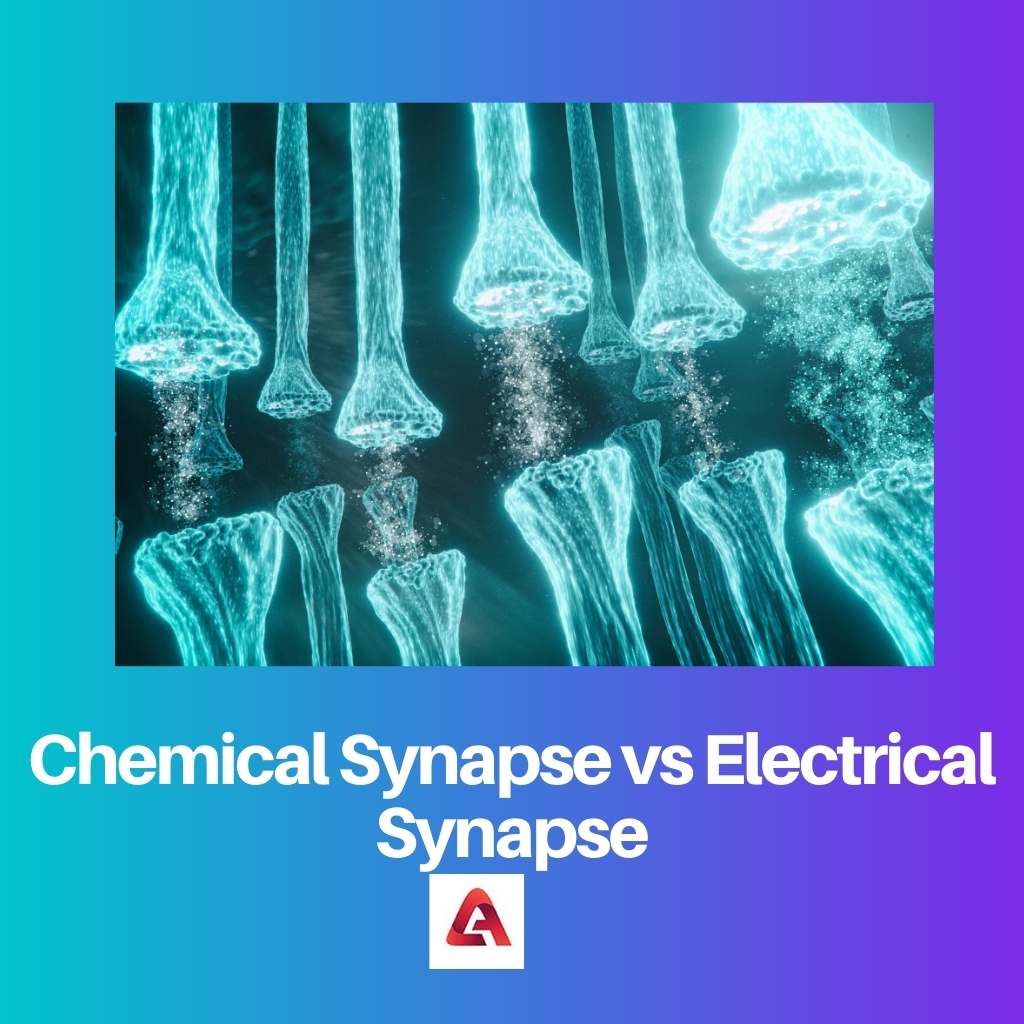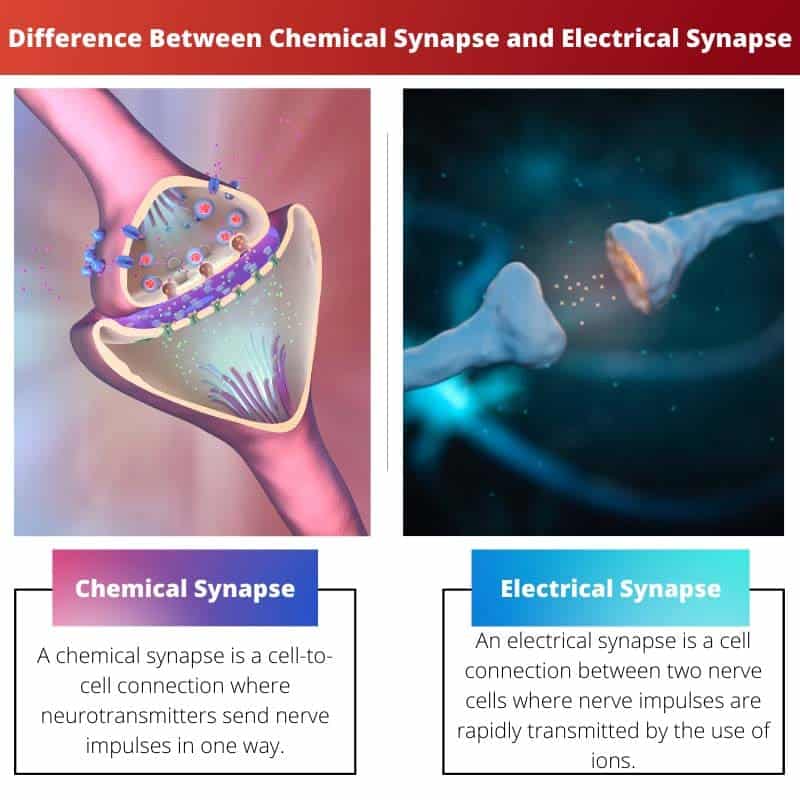A synapse is a structure that facilitates signal transmission from one neuron to another. In the neurological system, synapses are discovered.
They can send electrical or chemical signals. Electrical and chemical synapses are the two basic types of synapses that may be categorized based on the type of signal.
By bringing their plasma membranes closer together at the synapse, the interacting two neurons can transfer the signal more correctly and effectively.
Key Takeaways
- Chemical synapses rely on neurotransmitters to transmit signals between neurons.
- Electrical synapses use gap junctions for direct electrical communication between cells.
- Electrical synapses allow for faster signal transmission, while chemical synapses offer greater flexibility and modulation.
Chemical Synapse vs Electrical Synapse
The difference between a chemical and an electrical synapse is that in a chemical synapse, the nerve impulse is sent chemically via neurotransmitters, whereas in an electrical synapse, the nerve impulse is transmitted electrically via channel proteins. As an electrical signal, nerve impulses travel through the axon membrane. In the case of the former, that is, chemical synapse, an electrical signal is transformed into a chemical signal. On the other hand, an electrical synapse can convey the impulse through ions. Electrical synapses are, therefore, far quicker than chemical synapses.

Chemical synapse connections can be formed either between two neurons or a neuron and a non-neuronal cell. The non-neuronal cell can be of various types, like muscle, glandular, and sensory cells).
Each chemical synapse’s synaptic complex is a non-reducible fundamental unit that represents the bare minimum for effective chemical synaptic transmission.
The three components are the presynaptic element (an axon terminal), the synaptic cleft, and the postsynaptic element (a dendritic spine).
An electrical synapse is a structure that allows two neurons to interact with one another using electrical impulses rather than chemicals.
In an electrical synapse, the presynaptic neuron and the postsynaptic neuron’s membranes come close together and join by forming a gap junction.
The signal, which is in the form of an ionic current, then flows passively across the gap junction, enabling the signal to be sent. Connexons, which are protein channels, are used to produce a gap junction.
Comparison Table
| Parameters of Comparison | Chemical Synapse | Electrical Synapse |
|---|---|---|
| Definition | A chemical synapse is a cell-to-cell connection where neurotransmitters send nerve impulses in one way. | An electrical synapse is a cell connection between two nerve cells where nerve impulses are rapidly transmitted by the use of ions. |
| Occurrence | In higher animals, chemical synapses are present. | Lower vertebrates and invertebrates have electrical synapses. |
| One-way/Two-way | At a chemical synapse, messages are only sent in one direction. | At an electrical synapse, messages are sent in both directions. |
| Synaptic cleft size | The size of the chemical synapse is rather enormous (10-20 nm). | The electric synapse is a smaller version of the synapses (0.2 nm). |
| Chemo-receptors | In chemical synapses, chemo-receptors are found on the post-synaptic membrane. | Chemo-receptors do not exist on the post-synaptic membrane of electrical synapses. |
What is Chemical Synapse?
Chemical synapses are biological connectors that allow neurons to send impulses to each other as well as non-neuronal cells like muscles and glands.
Chemical synapses enable neurons in the central nervous system to create circuits. They play a critical role in the biological computations that underpin perception and cognition.
They let the nervous system communicate with and control other bodily systems.
The cell junctions via which nerve impulses are delivered in one direction by neurotransmitters are referred to as chemical synapses.
Pre-synaptic and post-synaptic membranes are the two types of plasma membranes. Pre-synaptic membranes are found in pre-synaptic cells, whereas postsynaptic membranes are found in post-synaptic cells.
Between the pre-synaptic and post-synaptic membranes is the synaptic cleft.
Interstitial fluid fills the gap between synapses. The voltage-gated calcium channels of the presynaptic membrane are opened when an action potential is detected at the terminal of the pre-synaptic membrane.
The calcium ion concentration in the synaptic cleft is about 10-3 M, while the concentration inside nerve cells is 10-7 M. Calcium ions go through calcium channels from the synaptic cleft to the pre-synaptic nerve cell.
This raises calcium levels within the presynaptic nerve cell, permitting synaptic vesicles to fuse with the pre-synaptic membrane and exocytosis neurotransmitters into the synaptic cleft.
These neurotransmitters go through the synaptic cleft and bind to receptors on the post-synaptic membrane. They cause an action potential to be induced on the post-synaptic neuron’s membrane.

What is Electrical Synapse?
An electrical synapse is a connection between nerve cells where nerve impulses are transmitted through ions.
An electrical synapse has a tiny synaptic cleft, and a gap junction connects the two plasma membranes of the neurons.
A gap junction comprises matched channel protein pairs in both the pre-synaptic and post-synaptic membranes properly.
The pore formed by each channel pair is significantly bigger than that of a conventional ion channel. As a result, big molecules can pass across these gap junctions in addition to ions.
Intra-cellular metabolites and second messengers can therefore travel between two neurons.
While electrical synapses are less common than chemical synapses, they are distributed throughout the nervous system and serve essential and distinct roles.
Electrical synapses have a completely different manner of neurotransmission than chemical synapses.
An electrical synapse’s presynaptic and postsynaptic membranes are relatively close together, and channel proteins produce gap junctions that physically link them.
Current can flow from one cell to the next through gap junctions.
Other molecules, including ATP, can permeate through the wide gap junction pores in addition to the ions that convey this current.
On the other hand, electrical synapses allow the action potential to be passively transmitted from one neuron to the next through the pores of the gap junctions.
Main Differences Between Chemical Synapse and Electrical Synapse
- At a chemical synapse, nerve impulses are sent as a chemical signal via neurotransmitters, whereas at an electric synapse, nerve impulses are transmitted as an electrical signal across gap junctions or low-resistance bridges.
- Synaptic vesicles and a considerable number of mitochondria can be found in chemical synaptic knobs, whereas electrical synaptic knobs have no synaptic vesicles and only a few mitochondria.
- Chemoreceptors are present on the post-synaptic membrane in chemical synapses, whereas on the post-synaptic membrane of electrical synapses, there are no chemoreceptors.
- Chemical synapses are seen in higher mammals, whereas electrical synapses are seen in lower vertebrates and invertebrates.
- Messages are only delivered in one way at a chemical synapse, whereas messages are delivered in both ways at an electrical synapse.


The article effectively distinguishes between chemical and electrical synapses, discussing parameters of comparison and providing a comprehensive understanding of both types of synapses.
The article’s coverage of gap junctions, ion transmission, and the distinct roles of electrical synapses in the nervous system is insightful. The detail provided on gap junctions and the permeation of molecules through them adds depth to the discussion.
I couldn’t agree more, the insights on electrical synapses are remarkable. The discussion on how electrical synapses allow the passive transmission of action potential through gap junctions is impressive.
The discussion of the roles and functions of chemical synapses in the central nervous system and the biological computations underlying perception and cognition is truly fascinating. It offers valuable insights into the importance of chemical synapses in neural communication.
The detailed comparison between chemical synapse and electrical synapse in terms of structure, function and mechanisms of signal transmission is impressive. The clarity of the information makes it easy to understand for individuals with interest in neurobiology.
This article provides an in-depth analysis of chemical and electrical synapses, discussing their structures, differences, and the way signals are transmitted through them. An excellent piece of information for anyone interested in the neurological system.
The detailed description of how nerve impulses are transmitted in both chemical and electrical synapses, as well as the differences in their synaptic cleft sizes and mechanisms of neurotransmission, provides a comprehensive view of their distinct properties.
The thorough explanation of the biological connectors and the process of synaptic transmission in chemical synapses is well-presented and informative. It enhances the understanding of how neurons communicate with other bodily systems.
The detailed explanation of electrical synapses, including their structure, function, and distribution throughout the nervous system, enriches the understanding of the unique roles they play in neuronal communication.